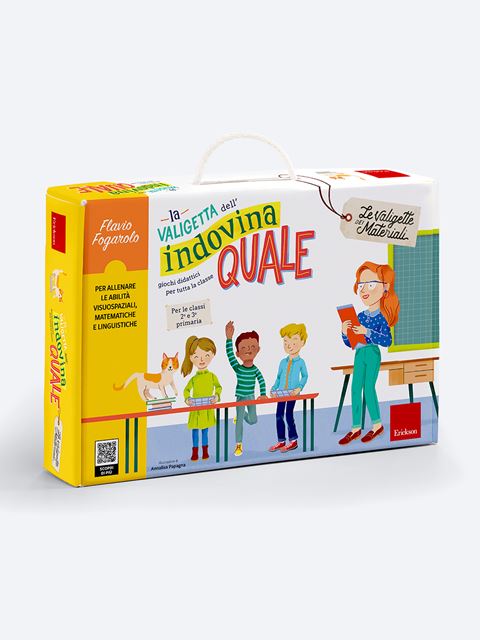 EN
EN
 PT
PT
Didactic games for the whole class

Product: Teaching tools
ISBN: 9788859018292
Publication date: 01/04/2019
Suitable for: Primary 1st level (ages 6-7), Primary 2nd level (ages 8-10)
REQUEST A SAMPLE OR MORE INFORMATION
A stimulating game for the whole class in which every child can win by developing attention, observation and logic skills. The games contained in the briefcase are designed to involve a large number of players, up to an entire class, but can also be used in smaller contexts, “both at school and at home with family.”
Objective: correctly guess items from one’s own folder by using a series of clues that exclude the incorrect items.
Folders for 24 players that can be used for 6 different games
88 clue cards and 2 card containers
Tokens to be cut out for everyone

Challenge your classmates with logic and mathematical skills
The Guess What Briefcase contains a series of games for practicing logic skills, stimulating observation, and putting the mathematical and linguistic knowledge learned in class to the test. The activities, designed for second and third grades of primary school, involve a large number of players. Proceeding by exclusion rounds, the students challenge each other in the search of the item that corresponds to a given description. In the end, however, all the players can be the winners!
BRIEFCASE CONTENTS
27 game boards, which can be photocopied or duplicated as necessary. Each player receives one game board. 4 different versions of each game board are available in order to avoid students copying from each other’s boards. The boards show images from 6 different settings:
Rooms in the house

Landscapes

Shapes

Nouns

Words

Numbers

The clue cards: composed of 6 phrases that contain hints for identifying the key element on each board
The clue card holder, so the clues can be read one at a time.
The markers: to indicate the elements that are gradually excluded


HOW TO PLAY
The game begins by choosing one of the 6 games in the briefcase, which are divided by type and color. The game boards are then dealt to each player, checking that players next to each other have different versions. The game handler, after drawing a clue card, inserts it into its container and slides it from bottom to top, reading the clues aloud.
Players will have to remove from their game board the items which they believe do not match the clue, thus leaving a single element at the end. By scrolling through the clues tab, you can find the answer to the clues.
Rarely will the game have only one winner!

THE THREE GAME LEVELS
Based on the skills of the players, the game can be played in three different levels:
Level 1 The clues can be read using the container that allows you to view first the number of items to be eliminated and then the clue phrase (the red one).
Level 2 Next, the container with only a window for the clues can be used (the blue one). In this way, the players don’t know how many elements should be eliminated.
Level 3 After choosing an item to identify, each player can take turns inventing the clues for eliminating the other items, trying to make the game last as long as possible.

DIDACTIC SUGGESTIONS
The game requires complex negation management. The clues for the objects which get eliminated contrast with the description of that item, with a consequent logical reversal of TRUE / FALSE. Example of a sequence of clues:WHO THE GAME IS FOR
The Guess What Briefcase is a didactic game that can be used to involve the entire class, given that the game boards can be photocopied based on the number of players. It can also be suitable for a smaller number of family players. The recommended target age ranges from second grade to third grade of primary school. The activities stimulate visuospatial, logical and mathematical abilities, but do not encourage any kind of competition, because in the end there can be more than one winner.THE AUTHOR
Flavio Fogarolo is a trainer who deals with inclusive education. For several years he was the contact person for disability and DSA at the Scholastic Office in Vicenza. He collaborated in the design of compensatory materials for Edizioni Centro Studi Erickson.